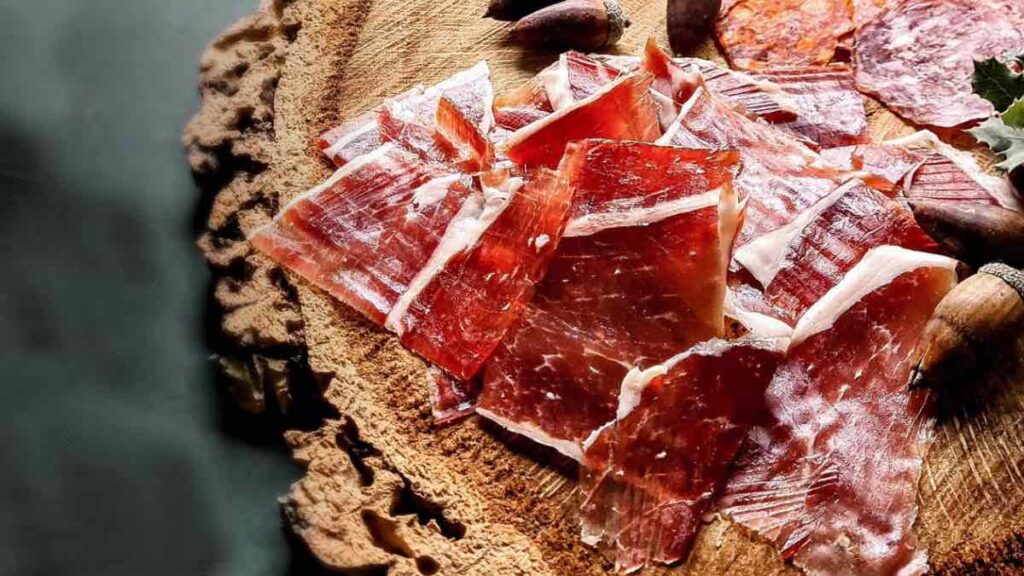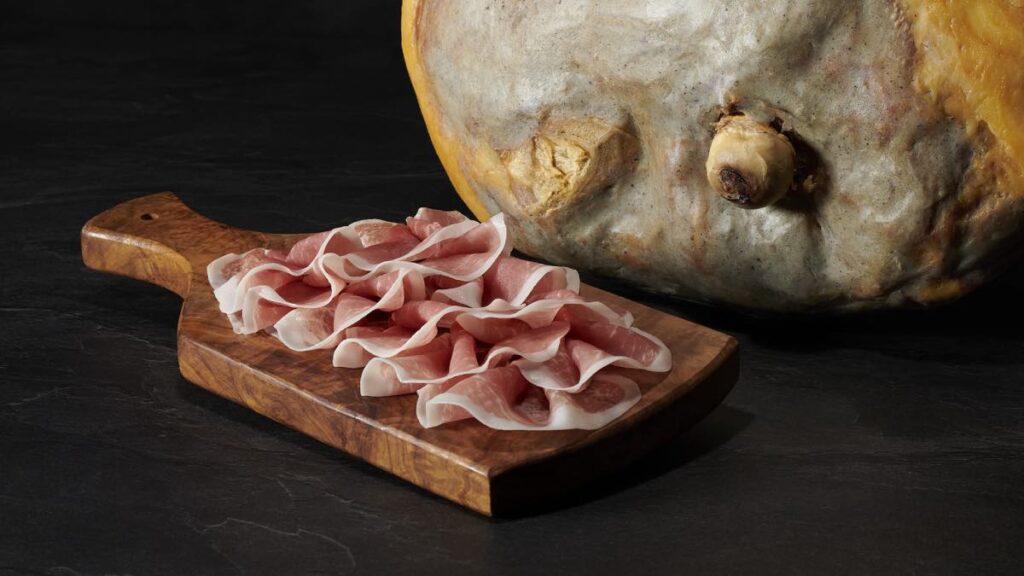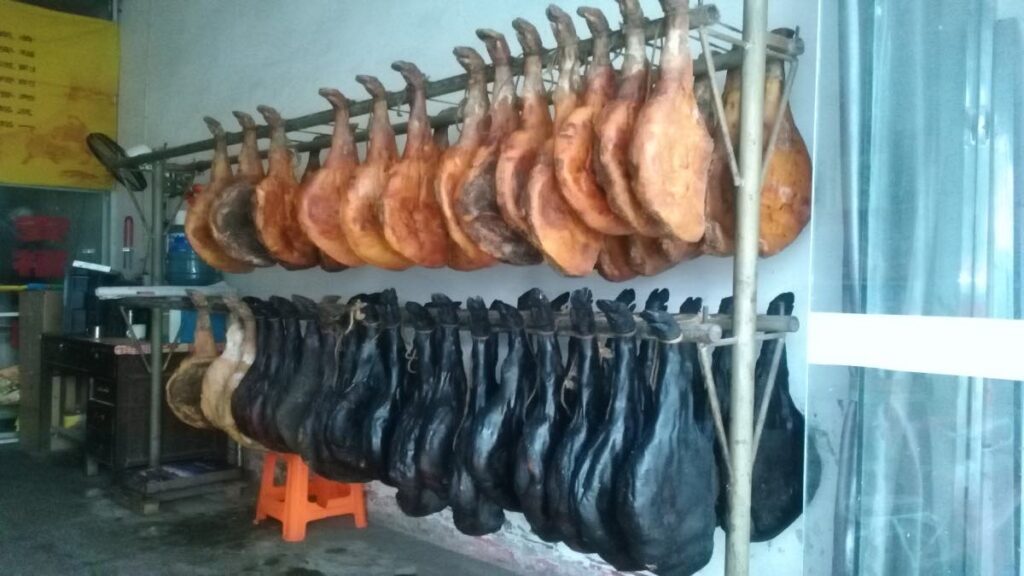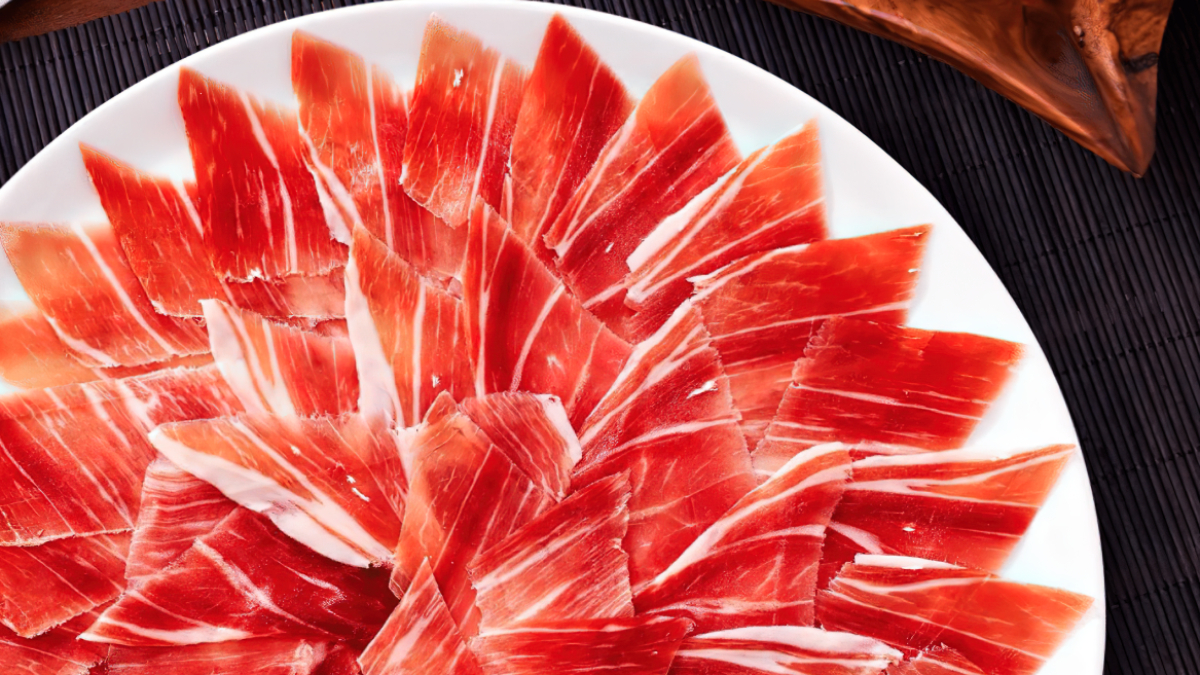Click here to read the Spanish version.
In Spain, ham is a true gastronomic emblem. We know it well, but it is worth remembering: «100% acorn-fed ham is a unique product because of its flavor, texture and nutritional content». This is explained by Rafael Guerrero, commercial director of Cooperativa Ganadera del Valle de los Pedroches (COVAP). The production of the ham is also unique: the pigs are raised in the wild for more than 14 months, fed on grass and acorns in the pasture, and the hams mature in natural cellars for more than 40 months (20 months for the shoulders), «where the master ham makers find the ideal location for them at all times, depending on the temperature and air flow they need».
In the peninsula we have been curing ham since the time of the Roman Empire -thanks to the introduction of the pig by the Phoenicians, back in the 12th century BC- and we have come a long way in the art of making it. – and we have come a long way in the art of making it, because four denominations protect and safeguard the quality of Spanish ham: Jamón Ibérico D. O. P. Jamón de Guijuelo, Jamón Ibérico D. O. P. Jabugo, Jamón Ibérico D. O. P. Los Pedroches and Jamón Ibérico D. O. Dehesa de Extremadura. And we have taken it far too: demand for the most gourmet ham is booming in the USA, China, South Korea, Italy, France and the UK, says Guerrero. And in Argentina they also make their own version, which they call ‘jamón crudo argentino’, and which tries to imitate Spanish ham.
But there are also other countries in the world where ham is also very important in their gastronomic culture. Here are some examples.
Portugal
The fame of Spanish Iberian ham has for years overshadowed one fact: that our neighbors in Portugal (also Iberian) make cured hams similar to ours. In the Douro region, in the north of the country, two hams are produced: Chaves ham and Lamego ham. Both are white-leg hams that are the jewel of the small local industry. From A Presunteca de Lamego, Hamilton Ferreira explains that their hams are already internationally recognized for their high quality, as they carefully select the right pork legs and subject them to a natural curing process of 18 months. A special microclimate does the rest: «the result is a ham with a unique palate and low salt content».

The variety of Portuguese hams does not end here. In the south, in the Alentejo region, Alentejo ham is produced. Its appearance is very similar to that of Iberian ham, since a black leg is chosen, but of smaller size. The consumption of Alentejo ham used to be confined to the local area but, recently, these legs have traveled outside the region to be known throughout the country, which demands high quality local products. Among them is the cousin of Spanish Iberian ham: the pure Iberian ham D. O. P. Barrancos, which is produced from the Alentejano breed of pig, which feeds on acorns in the local pastures.
France
Gastronomic excellence is something that is pursued in France to the last consequences, which are usually delicious. We have good examples of this in products such as cheese and wine and, in a healthy competition, the French have wanted to stand up to Spanish ham with their own ham: the Bayonne ham. Known as Jambon de Bayonne, this leg of pork has a trimmed leg and, according to the Consortium for its curing, salt from the Adour river basin is used to dry it at a low temperature.
Later, the pannage takes place: an application of a mixture of pork fat and flour that allows the ham to dry gradually during the long refining period of 7 to 12 months. In some hams, the red and spicy touch of Espelette paprika is also added. To recognize them at a glance, just look to see if they have been marked with the ‘Bayonne’ or ‘Lauburu’ stamp. And, once sliced, we will have in front of us a ham that is pinker than Serrano ham.
A diferencia de este (y de forma similar al jamón de las Ardenas) la carne del Jambon noir de Bigorre es mucho más oscura y su tiempo de secado es, como mínimo, de 12 meses. Es el jamón más exclusivo de los que se producen en Francia: las piernUnlike this one (and similar to the Ardennes ham), the meat of Jambon noir de Bigorre is much darker and its drying time is at least 12 months. It is the most exclusive ham produced in France: the legs come from pure-bred black bigorre Gascon pigs. Its flavor? Nuts, chestnuts and mushrooms. Pure umami.
Germany
Just when you thought it was all sausages and sauerkraut over there, Germany surprises you with its own ham. This is the Black Forest ham or Schwarzwälder Schinken, which has enjoyed a Protected Geographical Indication (PGI since 1997, and which determines only that the ham is produced in the region. For this, like all ham, it will undergo a salting and curing process but, in addition, Black Forest ham is seasoned with garlic, coriander seeds and black pepper, marinated and smoked with spruce and/or pine wood, as is done (if desired) with the Belgian Jambon d’Ardennes. Hence its highly aromatic and even spicy profile, which is unusual for a ham.
The regulations state that Black Forest ham must reach the consumer completely boneless, so do not try to look for the classic pork leg silhouette in German supermarkets. To consume it, the producers’ association recommends eating it just as we eat our Iberian ham: as is, with bread or as part of a recipe.
Italy
In case it was still not clear to you that Italian cured meats are the ‘hit’ -with pardon the paradox-, you will only have to try the different hams that come out of the land of pizza. Straight from the Emilia-Romagna region we have the two stars of the Italian ham league: the culatello di Zibello PDO and the better known Prosciutto di Parma PDO.
Giovanni Tortini, commercial manager of Salumificio Ducale, explains that the microclimate generated by the Po River and the Apennines provides a high humidity that gives culatello di Zibello PDO an added value, allowing it to mature and dry slowly. Of course, the choice of raw material (pigs raised on the Padana plains) and the artisanal preparation, make culatello an addictive bite. In Tortini’s words, «it has a captivating, sweet taste and a delicate, lingering perfume». Proof of this, sales figures have increased by 15% over the last year.

From the Consorzio di Tutella del culatello di Zibello they remind that there are only 23 producers in eight localities who are responsible for producing the real product, which in 2022 amounted to 102,591 approved pieces: Colorno, Roccabianca, Sissa, San Secondo Parmense, Soragna, Polesine Parmense, Busseto and, of course, Zibello. «The fog is a fundamental element for the natural maturation of the salting, coupled with the skills and knowledge of the masalen, the local butchers, which has been passed down from generation to generation, so as to properly cut and salt the thigh, stuff it into a bladder and tie it by hand.» Of course, the meat itself is defining: the Gran Suino Padano breed of pig, also known as Suino Pesante, raised in Emilia-Romagna and Lombardy.
On the other hand, but in the same region, we find the famous prosciutto di Parma P.D.O. «It is one of the most representative products of Made in Italy,» says Matteo Cavalli, of the Consorzio del Prosciutto di Parma. Two ingredients are used: legs of pork raised in ten different Italian regions and salt. Despite all this, it has an unmistakably sweet taste, which Cavalli explains by the climatic conditions in which it is matured. «There is growing interest from consumers, especially international ones: exports, especially to the United States, absorb a third of production.»
China
Chinese gastronomy surprises at every bite: the refinement of its techniques is so refined and the diversity of recipes so wide that it is impossible to get to know it completely. For this reason, when we discover that in China they also make their own ham, we are shocked.
In Jinhua, in Anfu, in Rugao and in Xuanwei, ham is produced in all these places, and this is not surprising, because it should be remembered that salting and drying is a well-known method for preserving a piece of meat for a long time.
In the case of the former, Jinhua ham, in the province of Zhejiang, was mentioned in writings of the Tang dynasty, between 618 and 907 A.D., which described precisely how to prepare it. It uses the hind legs of pigs native to China, called liang tou wu, whose characteristic is the black hair, both on their heads and hams, with some white specks. After salting, they are soaked and washed, then dried and shaped, trimming the fat and skin, removing the hoof and marking them with a stamp. They are left to dry in the sun until they begin to drip fat and are then matured, first hung for about eight months and then stacked, after brushing and oiling.

Once ready to eat, it can be eaten in slices or, more typically, added to soups. Meanwhile, Anfu ham (in Jiangxi province) is smoked, giving its skin a very fine and thin texture. This ham, along with Jinhua ham and Xuanwei ham, is considered one of the three great Chinese hams. It is also eaten alone or cooked, a typical recipe in the region being to cut the ham into cubes and add it to a dry potato and rice casserole to impart its flavor, which is often described as ‘potent’ and ‘dense’.
The third of the Chinese hams is the one produced in Xuanwei (Yunnan), which uses Wujin pigs and was the first to be mass-produced in 1990. It must be salted and massaged for ten days until it is stored and hung. In spite of everything, mold will appear on its surface -as occurs in a large number of sausages and hams-, something that will enrich its flavor, especially when matured for three or more years. It is said to be the Chinese alternative to the European versions of ham, although it is normally used as a flavoring or seasoning for soups or stews.
What do you think of Spanish ham?
Raquel Acosta, champion of Spain and official ham slicer of the Mandarin Oriental Ritz Hotel, explains that her career has taken her to slice and serve ham all over the world. In her travels she has been able to observe the faces of excitement and pleasure of people who have tasted the unique and potent flavor of the taste for the first time. «I really enjoyed being able to offer ham to people on the street, when I went on a promotional trip all over Europe to publicize the product. There were people who had never tried it before, because they couldn’t afford it, and their reactions were enthusiastic. It left a mark on me.
But, although it may seem impossible, not everyone likes ham. Acosta was able to witness, in a series of Spanish ham tasting sessions in a chain of supermarkets in different Latin American countries, the dislike of a slice of ham: «I remember that, for example, in San Pedro Sula, Honduras, there were people who tried it and took it out of their mouths. That new flavor – since they had never tasted it before – from the curing of a meat product, was too strong for them».
El desconocimiento del producto también le hizo tener que cuidar
The lack of knowledge of the product also made him have to be careful with the language: «If I said it was ‘cured’, they thought the ham had been sick. And I had to say ‘dry’ or ‘dehydrated’, when here we would associate it with something that was not juicy. In spite of everything, many people didn’t dare to try it because they thought it was an uncooked product that had traveled too far».

